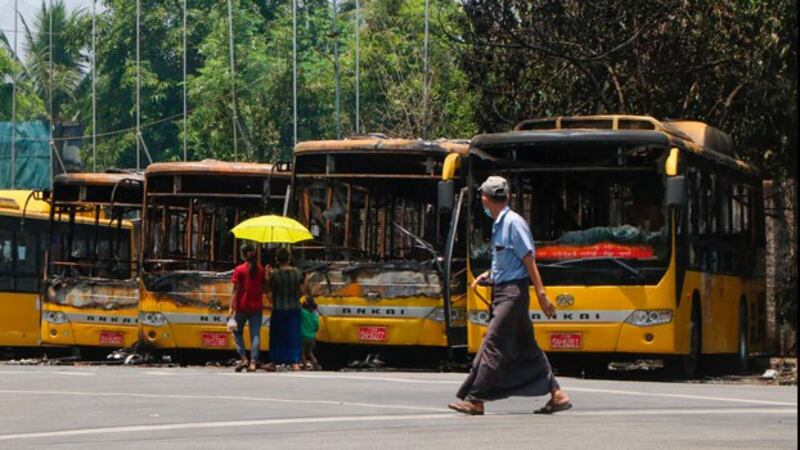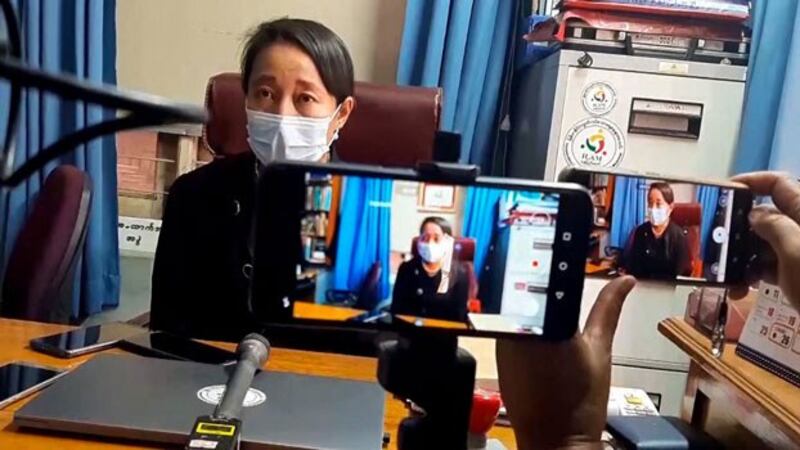Tens of thousands of civilians have fled the central Myanmar town of Bago in the wake of a massacre by junta security forces that left at least 100 people dead during dawn attacks on anti-regime strongholds three days ago, residents said Monday.
About 100,000 people have left their homes in the city and sought safe haven in nearby villages because of the brutal oppression by the army and the police, they said.
“The people fleeing their homes are residents of four neighborhoods in the city where the junta forces attacked,” said a Bago woman who declined to give her name. “There must be over 100,000 or so.”
Police and soldiers used rifle grenades and machine guns in the ferocious assault as they cleared barricades built by anti-junta protesters, leaving piles of bodies in pagodas and on school grounds of the ancient city, protest leaders said in an earlier report.
Some residents and social aid groups reported that security forces were demanding payments of 120,000 kyats (U.S. $84) before releasing the bodies of the dead to their families.
“The families of victims have been asked to give 120,000 kyats [U.S. $84] if they want to get the body of someone who died in the violence,” said a volunteer social worker who declined to give his name. “But if they go there just to look at and not ask for the body, then they are not charged any fee.”
Some people who paid the money to take home the bodies had to promise the security forces that they would not mention the matter to anyone, he added.
Heavily armed police and soldiers are now stationed at temples and schools throughout the city, 71 kilometers (44 miles) northeast of Myanmar’s former capital and commercial hub Yangon, and barricades have been set up in the neighborhood, residents said.
Security forces have ordered locals to remove their Thai-made PSI satellite TV dishes as part of a wider effort to cut off people’s access to information — a move that followed clampdowns on social media, Wi-Fi, and mobile internet since the military carried out the coup on Feb. 1.

Protesters hold ‘flash strikes’
Nationwide demonstrations intensified in the wake of the brutal attack in Bago, with “flash strikes” held against the regime on Sunday. During the nighttime protests, demonstrators shined lights from their cell phones and from flashlights as a show of opposition to the junta.
At least10 protesters and civilians were arrested at one event in Thinbawdan ward near the Yandanbon shipyard in Myanmar’s second-largest city Mandalay, residents said.
Police and soldiers broke down barriers set up to protect neighborhood locals before entering the area to make arrests, they said.
“It was about 9:15 p.m. when we were having this flash strike, said one local who requested anonymity. “We heard they were breaking down the barrier that we made with three huge metal doors near 26th Street. About 10 people got arrested.”
Some of the people apprehended were onlookers from nearby houses, he said, adding that protests in Mandalay continued on Monday.
In Yangon, five public transportation buses parked near the School for the Blind in Kyimyindaing township in western Yangon, were set ablaze early Monday, local said.
Fire engines arrived at about 5 a.m. to extinguish the fires, though four of the vehicles were totally destroyed.
It is not yet clear how the fires started, though junta forces were seen in the school compound during the dusk-to-dawn curfew.
Earlier during the night, police and soldiers fired marbles from slingshots at houses where residents banged pots and pans to show their disdain for the military.
In the capital Naypyidaw on Monday, the junta brought another criminal charge against deposed Myanmar leader Aung San Suu Kyi for violating government-mandated restrictions during the coronavirus pandemic, one of her lawyers said.
Min Min Aung, a member of the state counselor’s defense team, told RFA that state prosecutor Nyi Nyi filed the new charge against her for allegedly violating Section 25 of the Disaster Management Act. The military regime had previously filed a similar charge against Aung San Suu Kyi under the same statute.
“Another plaintiff has made the charge based on a violation of [COVID-19] regulations issued by the Ministry of Health — a violation of the stipulation that said no more than 30 people could assemble together,” said Min Min Aung following a video-conference hearing for Aung San Suu Kyi.
"[Mother] Suu has asked our defense team to handle all the charges filed against her," she added.
Aung San Suu Kyi now faces six charges — five in Naypyidaw and one in Yangon. Her next hearing is scheduled for April 26.

Air attacks continue in Tamu
In the town of Tamu in northwestern Myanmar’s Sagaing region, police and soldiers shot people on sight amid a round-the-clock imposition of martial law, residents and local civil society groups said.
“They’ve been shooting at people seen on the roads the whole night and this morning until about 8 a.m.,” said a local who declined to be named for safety reasons “They are stationed in the school. They are going to repress us mercilessly.”
Security forces have killed more than 20 people and arrested over 100 others amid violent crackdowns in the border town, which is home to ethnic Naga rebels. Tamu lies in the Naga Self-Administered Zone of Sagaing region.
Following a brutal repression of protesters on April 10, forces led by the Kukai National Organization and its armed wing, the Kuki National Army — an insurgent group active in Northeast India and northwest Myanmar — attacked junta forces, killing 18 men.
Various forms of peaceful protests against the military are in full force in other parts of Myanmar with young demonstrators trying to avoid direct contact with the police and army.
In neighboring Kachin state, the military continued air raids in the town of Momauk, killing seven civilians, including women and Buddhist monks, during a battle with Kachin rebels, residents said Monday.
The junta forces used heavy weapons and dropped bombs from fighter jets on nearby villages six times during the night and in the early morning, with some of the aerial attacks hitting homemade bomb shelters, they said.
Some civilians who were hit lost body parts, and local support groups were unable to reach them to provide emergency assistance because of the intensity of the conflict between Myanmar forces and the Kachin Independence Army (KIA), residents said.
At least 10 people have died in the attacks since April 10 amid the intensified armed conflict, locals said.
Myanmar forces lashed out after KIA troops overran an army post on Towertaing Hill near Momauk’s Sihat village at about 11 p.m. Sunday, they said. A few hours later, the fighter jets began bombing the area with heavy weapons.
“It started before 11 p.m., but we couldn’t look outside because it was dark and there was a lot of heavy shooting,” said a woman in Sihat who declined to give her name. “And then, the jets came and bombed five times after midnight and once in the early morning. An elderly woman died in our village, and we could not even find one of her hands.”
The shrapnel from the bomb that hit the elderly woman’s house landed near the Sihat villager’s own hiding place, the woman said.
Momauk resident Naing Lin said he and others could see “the fiery shells going through the dark sky.”

Shells dropped on houses
In the nearby village of Shwehintha, a shell dropped on a house, killing a man instantly and injuring his mother who was later taken to the hospital, he said.
“An old woman in Sihat village was also killed by a shell, and in Katkyaw village, the monastery was totally destroyed, and the abbot was taken to hospital for medical treatment,” Naing Lin said
Besides the two death, another abbot and four civilians in Matkwai village lost their lives in the attack.
Residents in the affected villages said they stayed in their bomb shelters without food until midday Monday, while others fled to safe havens elsewhere.
Because the fighting was still going on, it was difficult for local aid groups to travel to the area, they said.
KIA spokesman Col. Naw Bu confirmed the occupation of the army post near Sihat, and said the force also seized a police camp near Myothit village.
“There was a series of battles yesterday,” he said. “[The army post] at Towertaing Hill and a police station at Tada-Oo were taken yesterday, but the details of the conflict are not yet known.”
Government forces shelled the area heavily, hitting nearby villages and killing people, he added, but said he did not know the number of casualties.
RFA could not reach junta spokesman Maj. Gen. Zaw Min Tun for comment.
Fierce clashes have ensued between the KIA and five Myanmar Army battalions in the region since April 10, despite the government military’s announcement earlier this month that it would maintain a temporary cease-fire with rebel ethnic armies throughout the country.
Reported by RFA’s Myanmar Service. Translated by Khin Maung Nyane. Written in English by Roseanne Gerin.
